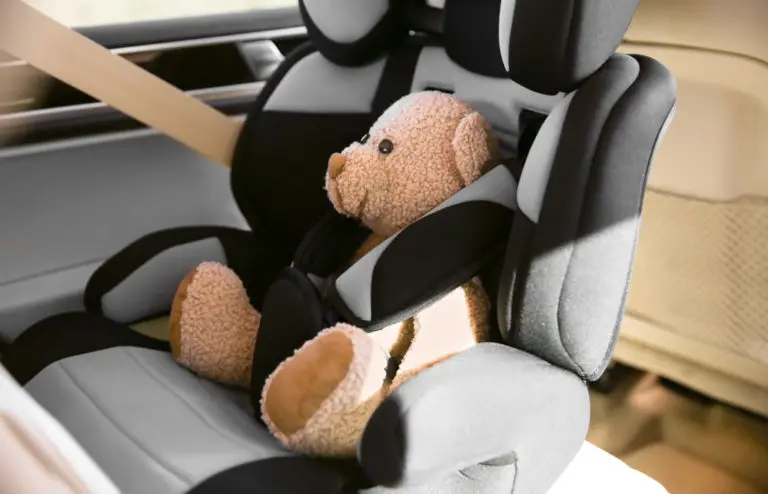Seat Belt Statistics in 2024 (Latest U.S. Data)
Seat belt use among Americans is rather high, but still, over half of the traffic fatalities involve unrestrained occupants.
Seat belt statistics show that buckling up is the single most effective thing you can do to protect yourself in a car crash.
Seat Belt Statistics
Overview of statistics on seat belt usage and safety:
- Over 23,000 Americans die each year in car crashes, 51% are unrestrained.
- Seat belts save about 15,000 lives each year in the U.S.
- Millennials have the lowest seat belt use rate of any age group in fatal crashes.
- Women are 73% more likely to be injured in a frontal car crash than men.
- About 1 in 10 fatal crashes involve car ejections, 90% of ejected are unrestrained.
- Unbelted occupants increase the risk of injury and death for belted occupants by 40%.
- Top reasons for not wearing a seat belt are short trips, forgetfulness, and discomfort.
- Seat belts reduce the risk of fatal injury on the front seat by 45%.
- 1 in 4 women admit wearing their seat belt incorrectly, under their arm.
1. Over 23,000 Americans die each year in car crashes, 51% are unrestrained.
According to National Highway Traffic Safety Administration (NHTSA) seat belt fatality statistics, over 23,000 Americans die each year in fatal car crashes. (1)
There were 38,824 traffic fatalities in the U.S. in 2020, of which 23,824 (61%) were occupants of passenger vehicles.
| Killed in 2020 | Unrestrained in 2020 | Killed in 2011 | Unrestrained in 2011 |
| 23,824 | 51% | 21,316 | 52% |
According to seat belt death statistics, based on known restraint use, 51% of passenger vehicle occupants killed were unrestrained and 49% restrained.
The number of unrestrained vehicle occupants killed in 2020 is the highest it has been in that 10-year period.
In fatal car crashes, 61% of pickup truck occupants are unrestrained.
Not wearing a seatbelt statistics show that based on known restrain use, 61% of pickup truck occupants who were killed in fatal traffic crashes were unrestrained. (1)
| Vehicle Type | Killed in 2020 | Unrestrained | Restrained |
| Passenger Cars | 13,472 | 47% | 53% |
| Pickups | 4,330 | 61% | 39% |
| SUVs | 5,075 | 53% | 47% |
| Vans | 933 | 45% | 55% |
*The total number of occupants does not include other/unknown light/vehicle types.
Based on known restraint use, 53% of SUV occupants who were killed were unrestrained, compared to 47% of passenger cars and 46% of vans.
2. Seat belts save about 15,000 lives each year in the U.S.
According to NHTSA seat belt effectiveness statistics, seat belts saved 14,955 lives in 2017. (1)
| Restraint System | Lives Saved 2016 | Lives Saved 2017 | Total Lives Saved 1975-2017 |
| Frontal Air Bags | 2,772 Lives | 2,790 Lives | 50,457 Lives |
| Child Restraints | 319 Lives | 325 Lives | 11,606 Lives |
| Seat Belts | 14,753 Lives | 14,955 Lives | 374,276 Lives |
| Could Have Been Saved at 100% Seat Belt Use | 2,715 Lives | 2,549 Lives | 386,719 Lives |
If all passenger vehicle occupants 5 and older had worn seat belts, an additional 2,549 lives could have been saved. Seat belts save lives.
Since 1975, seat belts have saved over 374,276 lives in traffic crashes. If all passengers had worn seat belts, an additional 386,719 lives could have been saved.
3. Millennials have the lowest seat belt use rate of any age group in fatal crashes.
According to NHTSA seat belt use statistics, Millennials have the lowest (39%) seat belt use rate of any age group in fatal crashes. (2, 3)
| Gen Z Ages 7-22 | Millennials Ages 23-38 | Gen X Ages 39-54 | Boomers Ages 55-73 |
| 44% Restrained | 39% Restrained | 47% Restrained | 58% Restrained |
Of all occupants involved in motor vehicle crashes in 2020, Gen Z has a 44% of seat belt use rate, Gen X 47%, and Boomers 58%.
The total seat belt use rate in the U.S. is 90.4% of front-seat passengers.
According to NHTSA seat belt usage statistics (2021), the seat belt use rate of front-seat passengers is 90.4%. (4)
| Total Seat Belt Use in 2021 | Seat Belt Use in 2021 | Seat Belt Use in 2021 |
| 90.4% of Occupants | 90.6% of Drivers | 89.4% of Passengers |
The seat belt use rate represents the percentage of occupants who are belted during an average daylight moment.
Seat belt use over a 15-year period has been on an upwards trend. In 2007, the seat belt use rate was 82.5%, 88.5% in 2015, and 90.4% in 2021.
The seat belt use rate is the highest in states with primary enforcement laws.
According to NHTSA seat belt law statistics, the seat belt use rate is 91% in states with primary seat belt laws compared to 88% in states with secondary seat belt laws. (4)
| Seat Belt Rate Primary Law | States With Primary Law | Seat Belt Rate Secondary Law | States With Secondary Law |
| 91% | 34 States | 88% | 15 States |
In the U.S., adult seat belt use laws are in effect in 49 States, the District of Columbia, and Puerto Rico. (1)
In 2020, the District of Columbia, Puerto Rico, and 34 states had primary seat belt laws in effect by enabling police officers to stop vehicles and write citations when they observed violations of the seat belt law.
In 2020, 15 states had secondary seat belt laws in effect, where police officers were permitted to write citations only after vehicles were stopped for some other traffic infraction.
New Hampshire is the only state without a seat belt law for adults, although it does have a primary child passenger safety law that covers all drivers and passengers under 18 years old.
4. Women are 73% more likely to be injured in a frontal car crash than men.
According to the University of Virginia’s Center for Applied Biomechanics seat belt crash statistics, belted women are 73% more likely to be injured in a frontal car crash than men. (5)
| Belted Women in Frontal Crashes | Belted Women in Car Crashes |
| Injured 73% More Likely | Killed 17% More Likely |
According to NHTSA seat belt injury statistics, a female driver or a front passenger who is wearing her seat belt is 17% more likely to be killed in car crashes compared to males. (6)
Researchers suggest that the majority of automotive safety policy and research is designed to address the body of the 50th percentile male. (6)
| 5th % Female Dummy | Avg. Female Adult | Difference | |
| Year | 1970 | 2018 | +48 yr |
| Weight | 108 lb | 171 lb | +63 lb |
| Height | 59 in | 64 in | +5 in |
| 50th % Male Dummy | Avg. Male Adult | Difference | |
| Year | 1970 | 2018 | +48 yr |
| Weight | 171 lb | 200 lb | +29 lb |
| Height | 69 in | 69 in | – |
The 50th percentile man, first standardized in the 1970s, is a 171-pound, 5-foot-9-inch dummy. The average American man today is about 29 pounds heavier. (7)
In order to address the inequality in crash outcomes, NHTSA required the use of a 5th percentile female dummy. The average American woman today is about 63 pounds heavier.
According to CDC seat belt safety data, today’s average female is 5 inches shorter and 29 pounds lighter than the average man. (6)
As a result, females may sit closer to the steering wheel or wear their seatbelts differently from males.
5. About 1 in 10 fatal crashes involve car ejections, 90% of ejected are unrestrained.
According to NHTSA seat belt ejection statistics, in 2020, there were 55,517 fatal crashes where injury, ejection, and restrain use were known. (8)
| Fatal Crashes | Car Ejections | Ejected | Ejected & Killed |
| 55,517 in 2020 | 11% of Crashes | 90% Unrestrained | 84% Occupants |
Based on known injury, ejection, and restraint use, about 11% of fatal crashes had car ejections.
This percentage varies tremendously depending on whether the occupant is restrained or unrestrained.
| Injury Type | Restrained | Unrestrained | Total Ejected |
| Fatal | 490 | 4,425 | 4,915 |
| Injured | 90 | 839 | 929 |
| Not Injured | 4 | 10 | 14 |
| Total | 584 | 5,274 | 5,858 |
Seat belt accidents statistics show that out of all fatal crashes with ejections, 90% of ejected occupants were unrestrained and 10% restrained. (8)
In 2020, 84% of vehicle occupants who were ejected from vehicles were killed. Out of all occupants ejected and killed, 90% were unrestrained and 10% restrained.
6. Unbelted occupants increase the risk of injury and death for belted occupants by 40%.
According to research on seat belt accident statistics, exposure to unbelted occupants is associated with a 40% increased risk of any injury. (9)
| Risk of Any Injury | Belted at Risk | Risk of Death |
| 40% Increase | 90% Increase | 4.8x Increase |
Belted at risk vehicle occupants were at a 90% increased risk of injury, but unbelted occupants were not at increased risk. (9)
Interestingly enough, risks were similar for non-incapacitating and capacitating injuries.
Not wearing a seatbelt data shows that unbelted occupants also increased the risk of death for exposed belted occupants by 4.8 times, but no increased risk of death for unbelted occupants.
The accidents without seatbelts study concluded that belted vehicle occupants are at an increased risk of injury and death, in the event of a car crash, from unbelted occupants.
7. Top reasons for not wearing a seat belt are short trips, forgetfulness, and discomfort.
According to the Insurance Institute for Highway Safety (IIHS) wearing seat belts statistics, the top reasons for part-time seat belt wearing are short-distance drives, forgetfulness, and discomfort. (10)
| Seat Belt Users | Reason | Agreed |
| Part-Time | Driving a short distance | 67% |
| Part-Time | Forgetting | 60% |
| Part-Time | Discomfort | 47% |
| Non-Users | Discomfort | 77% |
| Non-Users | Not needing a seat belt | 54% |
| Non-Users | Disliking being told what to do | 50% |
Driving a short distance is the most common reason (67%) for not wearing a seat belt for part-time belt users.
Despite the fact that 52% of reported crashes occur within five miles from home and 77% from within 15 miles. (11)
Discomfort is the most common reason (77%) for not wearing a seat belt for non-users of seat belts.
8. Seat belts reduce the risk of fatal injury on the front seat by 45%.
According to NHTSA seat belt safety statistics, seat belts reduce the risk of fatal injury to front-seat passenger car occupants by 45%. (1)
| Vehicle Type | Fatal Injury to Front Seat | Moderate to Critical Injury to Front Seat |
| Passenger Car | 45% Decreased | 50% Decreased |
| Light Truck | 60% Decreased | 65% Decreased |
Seat belts reduce moderate-to-critical injury to front-seat passenger car occupants by 50%.
The seat belt injuries statistics data also show that seat belts reduce fatal injury to front seat light-truck occupants by 60% and moderate-to-critical injury by 65%. (1)
According to car seat statistics, child safety seats reduce fatal injury by 71% for infants, 54% for toddlers.
9. 1 in 4 women admit wearing their seat belt incorrectly, under their arm.
According to the Road Safety Authority (2022) seat belt misuse statistics, 26% of women admit to having worn their seat belt under their arm rather than on their shoulder. (12)
| Belt Under the Arm | Always or Often | Friends are Also Wearing |
| 26% of Women | 11% of Women | 32% of Women |
The seat belt wearing data shows that 11% who wear their seat belt under arm do so often or always. (12)
32% of study participants say that their female friends have also worn seat belt under their arm at least sometimes.
Placing the shoulder strap of the seat belt under your arm leaves your upper torso (neck, face, and head) completely unrestrained during a collision.
In such a situation, you would be exposed to horrific injury.
| Reasons for Wearing Seat Belt Under Arm | Percentage |
| To relieve neck irritation | 42% |
| General comfort | 20% |
| To allow greater movement/ flexibility | 11% |
| To protect clothing | 6% |
| To protect a spray tan | 7% |
| Makes the seatbelt less visible | 1% |
| Other | 14% |
The improper seat belt use statistics also found that the main reason (42%) for putting the seat belt under the arm is to relieve neck irritation. (12)
The second most common reason for seat belt misuse is general comfort (20%), followed by allowing greater movement (11%), and protecting clothing (6%).
References
- National Highway Traffic Safety Administration. 2022. Traffic Safety Facts. Occupant Protection in Passenger Vehicles. Link
- National Highway Traffic Safety Administration. 2022. Fatality Analysis Reporting System (FARS). All Occupants Involved in Motor Vehicle Crashes. Vehicle Body Type: Passenger Car or Light Truck – Pickup or Light Truck – Utility or Light Truck – Van or Light Truck – Other; 55 Years <=Age<= 73 Years; Person Type: Driver or Occupant. Years: 2020. Link
- Pew Research Center. 2019. Defining generations: Where Millennials end and Generation Z begins. Link
- National Highway Traffic Safety Administration. 2021. Traffic Safety Facts. Seat Belt Use in 2021 – Overall Results. Link
- The University of Virginia. 2019. Study: New Cars Are Safer, But Women Most Likely To Suffer Injury. Link
- Consumer Reports. 2019. The Crash Test Bias: How Male-Focused Testing Puts Female Drivers at Risk. Link
- Centers for Disease Control and Prevention. 2022. Body Measurements. Link
- National Highway Traffic Safety Administration. 2022. Fatality Analysis Reporting System (FARS). Total fatal crashes where injury, ejection and restraint use is known. Occupants Involved in Fatal Crashes. Vehicle Body Type: Passenger Car or Light Truck – Pickup or Light Truck – Utility or Light Truck – Van or Light Truck – Other; Person Type: Driver or Occupant. Years: 2020. Link
- MacLennan PA, McGwin G Jr, Metzger J, Moran SG, Rue LW 3rd. Risk of injury for occupants of motor vehicle collisions from unbelted occupants. Inj Prev. 2004 Dec;10(6):363-7. doi: 10.1136/ip.2003.005025. PMID: 15583258; PMCID: PMC1730165. Link
- Insurance Institute for Highway Safety. 2014. Attitudes toward seat belt use and in-vehicle technologies for encouraging belt use. Link
- Autoweek. 2002. Survey finds vehicle crashes most likely to occur close to home. Link
- The Road Safety Authority (RSA). 2022. 1 in 4 women admit wearing their seat belt incorrectly*. Link

Laurel Davidson
Laurel brings her passion for parenting and years of problem-solving experiences to ParentingMode. She is the editor of ParentingMode, ensuring that the content is relevant and valuable to the readers. Laurel received her master’s degree in public administration with a certificate in economic development. She is a stay-at-home mom, raising two adorable kiddos, Aurora and Thomas. Laurel enjoys sharing her experience as a parent, traveling, and good food.






